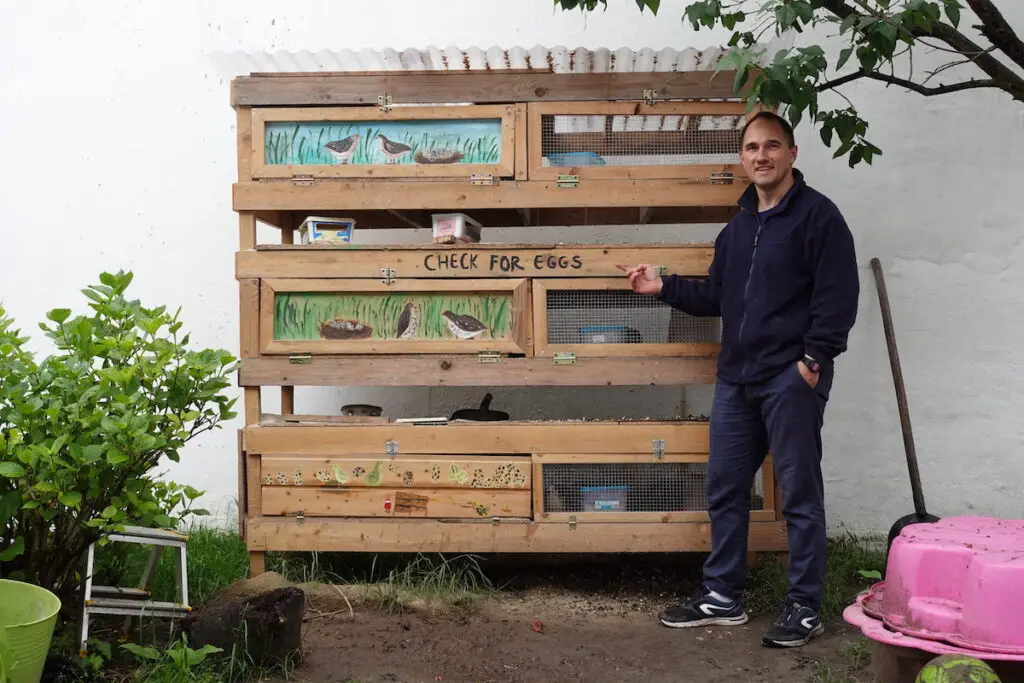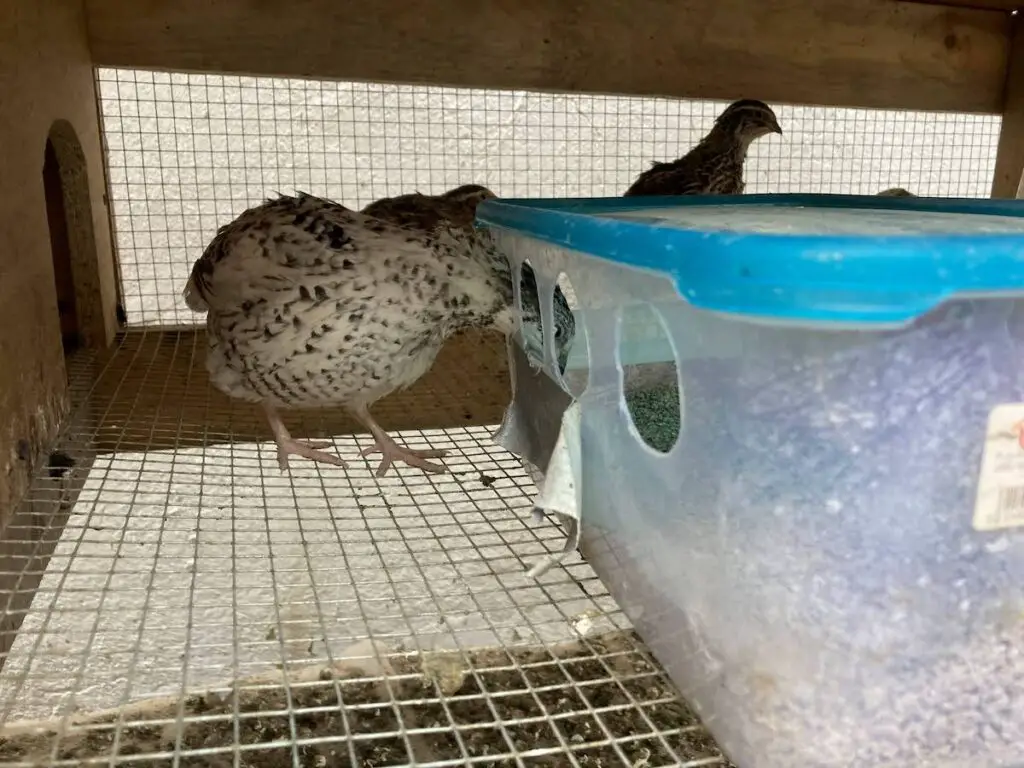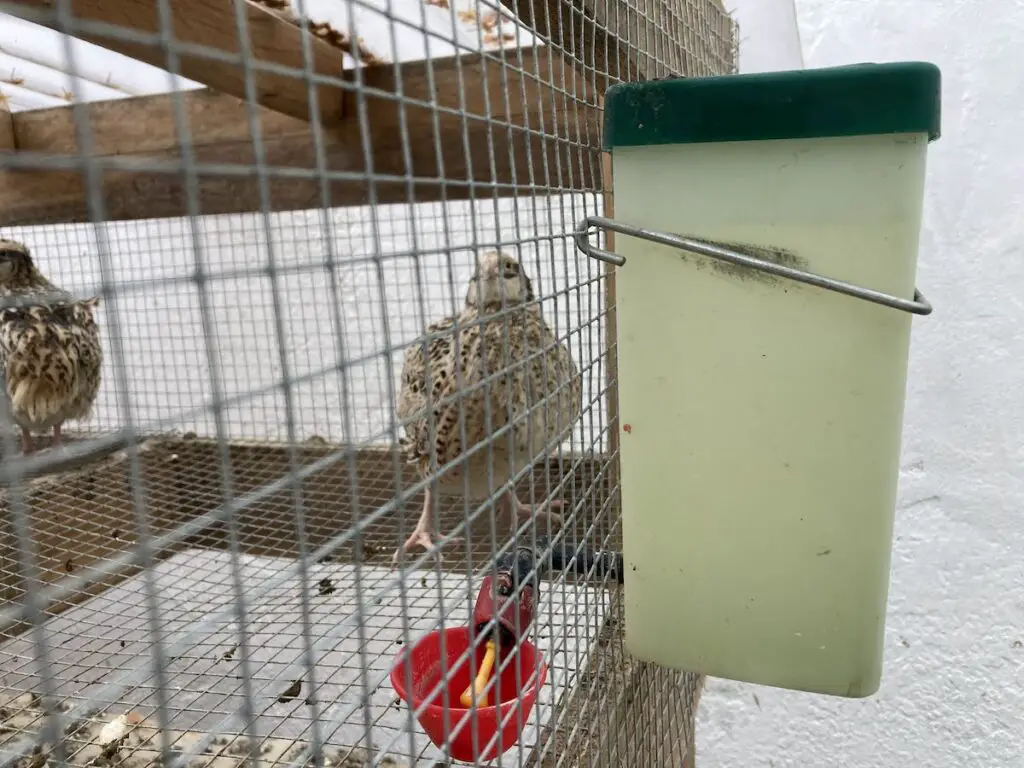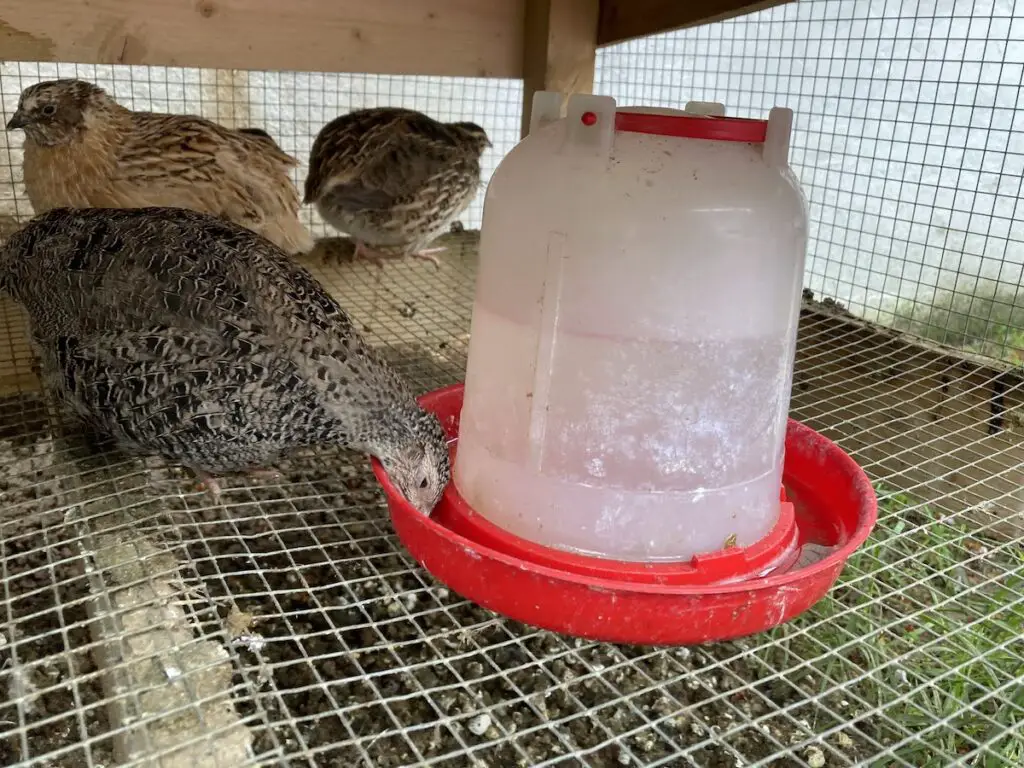If you want an abundant supply of quail eggs to feed your family, to gift to your extended family and friends, or maybe even sell some for a profit, this post is going to help you understand all the basics you need to know to get started keeping quail for eggs. Quail are prolific egg layers, and an excellent choice as a first step towards homesteading.
Here are the main steps involved if you want to keep quail for eggs:
- Calculate the number of birds you need
- Calculate the space you need for your birds
- Purchase the necessary equipment
- Purchase your quail
- Dial in and follow a daily/weekly/monthly routine
- Understand quail behavior
Although there is a fair amount of overlapping between keeping quail for meat or breeding them for profit, in this article we’re focusing on keeping quail specifically for eggs. It’s the easiest and the most rewarding reason to keep these fun little animals. If you want to raise quail for meat, read this other post that deals with the specifics of keeping quail for meat.
I’m going to focus on the simplest way you can get started as a beginner and the way I recommend all my friends who want to join this journey.
Learn how to raise your own quail and have an unlimited supply of eggs and meat.
How many birds?
If you’re new to raising quail, you may not know that if you want to keep quail for eggs only, it’s OK to keep hens only; they will lay eggs even if you have no roosters. This is good news because it means less aggression in the cage, no “wasted money” on food (roosters eat but don’t produce), and no need to cull birds regularly, which some people find emotionally impossible.
Quail are prolific egg-layers, and they will reward you with an egg almost every day, provided they get a balanced diet and sufficient light. My covey of 42 hens gives me 40 eggs a day.
If you already consume quail eggs, the math is simple: you need as many quail hens as many quail eggs you consume, and add in a few more (I like calculating with an additional hen for every 7 hens).

If you have no experience with quail eggs, consider that they are about 1/4 of the size of regular chicken eggs. Figure out how many chicken eggs you consume daily, and you can easily do the math.
Keep in mind that you can use quail eggs for EVERYTHING. You can eat it raw, boiled, fried, scrambled, and you can even use it for baking, just like you use chicken eggs. They can be kept fresh in the fridge for weeks, so don’t worry if there are days you don’t eat any: you can always use them later when you need more.
You can even use it in recipes where the egg yolk and egg white must be separated.
(After trying several ways, I found that the easiest way to remove the yolk of the quail egg from the white is by breaking a whole egg into a small bowl and scooping out the yolk with a teaspoon.)
Here are a few examples of how many quail you need in different scenarios.
A person living alone who eats an egg every other day needs 2 – 3 quail hens.
A couple that consumes 2 chicken eggs daily needs 8-10 quail.
A family of 5 that purchases 24 chicken eggs a week needs 16 quail.
A family of 7 that buys 30 chicken eggs a week needs about 20 quail.
How much space?
Quail unlike chickens, don’t require a lot of space. Some people choose to keep them in aviaries, but they can also be kept in cages.
If you use a cage, you can keep 1-4 birds per square foot. 4 birds per square foot is still OK in a laying cage if there are no roosters, but it would be too crowded for a breeding cage.
When it comes to selecting the cage, you can build the cage yourself (which is what I did), or you can purchase pre-made cages. There is a huge variety available, but I like the Hatching Time cages, and I think they make the perfect cage for any new quail keeper. They are modular, which means that they can be tailor-made to your size requirements; they are made of plastic and thus are rust-free, and they incorporate the cage and the feeding and watering system. You can purchase them on their website directly or on Amazon here.
A flock of 10 birds can be kept in a small, 3-4 square foot cage. I recommend planning to have a larger cage than you initially think, as you may want to increase the size of your flock after a while.
I built a cage for my own birds, and I made it larger than needed intentionally. It is 200 cm wide, 70 cm deep (78.5″ x 25.5″), and it has three floors, which gives me a total of 4.2 square meters (45 sq feet) of floor space. I only keep 60 birds across all three levels, but the numbers always change as I hatch new ones and cull some roosters.
- The top level is a dedicated breeding cage. I keep only 10 birds here (2 roosters and 8 hens).
- The middle level is a dedicated layer cage with 1.4 sq meters of space (15 sq feet). Currently I keep only 16 birds here, but it could host up to 60 birds if I wanted to.
- The bottow level is a grow-out cage where I place quail that need to move up from the brooder after hatching.

Initial investment
The fastest way you can start having your own quail eggs is by purchasing mature quail hens. You save yourself the expense of the incubator and the time it takes for hens to grow out. Also, you don’t need to worry about sexing the quail and culling the roosters.
If you purchase adult quail hens, these are the things you need:
Cage
Unless you already have the raw materials to build one, the cage is your biggest expense by far. Expect to pay anywhere between 100 and 500 dollars on a good, safe cage.
When I built the cage for my birds, the raw material (lumber, hardware cloth, screws etc) cost me around 250 dollars, which was a surprise to me because I expected to pay much less. Still, if I had bought the same size outdoor cage, I would have paid well over 1000 dollars.
I wrote an entire article about quail housing and how to choose the perfect habitat for your quail here on This Happy Farm, which you can read here.
Feeder and waterer
A good feeder and waterer are essential. You need to ensure that your quail have access to water and food at all times.
In my experience, hungry and thirsty quail quickly turn against each other, and they can be very vicious toward each other. When food or water arrives after not having access to any, they all want immediate access, which can lead to some injuries too.
My feeder of choice is a simple plastic Tupperware box with holes on its side. I’d love to say that it completely eliminates food waste, but that’s not the case 100% of the time. Quail are messy eaters, and I’m still looking for the perfect solution.



For watering, I use a cup-style reservoir as well as a mason jar. I much prefer the cup-style watering system because it is much cleaner. The mason jar always ends up very messy and needs to be cleaned every time I refill it. It collects manure and grit from the quail.
Since the water container is located outside the cage, it’s also easier to refill than the jars that need to be removed.
Food
Feeding your quail is an ongoing expense you need to calculate. If you have mature quail hens, you only need to give them quail layer feed.
Their food is slightly different from chicken feed as it contains different amounts of proteins, calcium and other nutrients. If quail specific feed is not available, you can use a generic gamebird feed, pheasant feed or turkey feed as well.
If you can’t get your hands on any of the above options, you can also use chicken feed. I tried it once when I couldn’t buy specific feed for them, and I didn’t notice any difference in egg production. I don’t know how it affects them in the long run though.
To plan how much food you can expect to give your quail, I wrote a detailed article that explains everything you need to know about feeding quail here.
Waste management
Not only do quail eat and lay eggs, they also produce quite a lot of waste. Their manure can’t be added directly to fertilize plants, but it is a great material to add to you compost. It takes approximately 6 months for quail manure to break down and be used as an excellent fertilizer.
If you have a small compost box and only a few birds, this may never become an issue, but if you keep many birds, and you don’t have a place to put their droppings yet, you need to consider this aspect as well.
A compost box like this one on Amazon can help you manage quail waste efficiently.
Getting your quail
Once you have everything set up and ready to go, you need to purchase some quail.
As a beginner, you rely on the expertise and knowledge of the seller, so make sure that you buy from someone you can trust. If you know a friend that keeps quail, you can get it from them, or you can also go to a quail farm that happily assists you and sell you the perfect quail you need.
My Shire Farm farm is a go-to place for many, and I recommend them if they ship to your area. Zach offers a lot of great information about quail on his YouTube channel and it’s a real family business that cares about you and your success.
Here are the things to keep in mind when you buy quail:
Buy them 6-8 weeks old. They may have started laying at this point, or they may be about to start laying. They will ramp up their egg production by week 12. This gives you enough time to get to know them, and for them to feel comfortable at their new home.
Buy hens only (provided that you only want to keep them for eggs). If you buy any of the regular colors (Pharaohs, Italians), you can easily tell apart hens from roosters by looking at their chest feathers (hens have spotty feathers on their chest).
Jumbos vs regular. Jumbo quail lay slightly larger eggs (12-14g instead of 10-11), but they lay fewer in a year than regular quail (approximately 10% less). I prefer jumbo quail because their eggs are easier to handle. If you want the same amount of eggs from jumbos as from regular quail, I recommend getting an extra quail for every 10 you buy.
Routines
Quail don’t need a lot of TLC. As long as you keep their cage clean and they are fed and watered, they live a happy life and provide you with eggs. I spend less than an hour a week caring for my quail.
Here are my routines:
Daily:
- Top up water and food (morning and evening). Less than 5 minutes
- Collect eggs in the evening
- A quick check to make sure everyone is alive
Weekly or every few days:
- Clean cage and remove manure (This depends on how your pen is set up. Outdoor wire-bottom cages are very practical)
- Observe your quail for a few minutes for irregular behavior
- Check each quail briefly (without removing them) to see if there are minor injuries to keep an eye on.
Every few months:
- Top-up sandbox (if they have one)
- Deep clean the cage
- Maintain any worn/broken part of the cage
Quail behavior 101
After you purchase your first batch of quail, you’re going to enjoy watching them. At first, they all seem very similar, but as you get to know them, you’re going to see that there is a pattern of behavior in the covey as well as in some individual birds.
Daily routine
Let’s see how your quail behave throughout the day so you understand what you can expect. In my observation, the pattern of the day can be divided in five parts: morning, early afternoon, afternoon, evening and night.
Morning
Quail usually wake up when it gets bright and immediately start looking for food. You can hear that they are active in this period. Hens are not noisy at all, but if you have a wire-bottom cage, you can hear their claws clicking, and they are excited about getting some food.
If you have roosters among your quail, this is when you hear them crow a lot, and you can observe breeding activity in the cage.
Make sure that they have access to food as soon as they wake up. I top up their food and water the night before.
Early afternoon
The quail are having their down-time, they digest the food from the morning and the hens are preparing to lay eggs later on. They are not very active in this period.
Afternoon
Your quail hens start laying eggs at round 3 pm and continue to lay until 7-8 pm. You can often hear “egg songs”, which tells you that a hen has just laid an egg.
Evening
Quail are usually active in the evening. They replenish their body and they prepare for the night. This is a similar period to the morning.
If you have roosters, you can hear them crow as the light is fading away.
Night
Quail go to rest and to sleep once it gets dark. This is a very calm and quiet period for them. If you hear any noise at night, it may be due to a predator or some other source of stress.
Stress
Stress is one of the factors that most affect egg production. Stressed birds don’t lay as many eggs or they may stop laying altogether.
Quail react to different types and intensities of stress in different ways.
Some quail get stressed when you hold them in your hand, while others don’t mind it.
The worst kind of stress is what comes from a predator. Racoons, rats and foxes, among others, all prey on quail. They are at the bottom of the food chain. If you hear them stress at night or if you see some of them missing limbs or bleeding in the morning, it’s a sure sign that you have some unwanted visitors.
Aggression
As cute as quail are when they hatch or even when you see them for the first time, they can be very aggressive toward each other.
The good news is that aggression typically doesn’t happen in a covey of hens that grow up together. If you keep hens for eggs only, this may not be an issue at all.
Observe the cage, and try to understand if you have behavior issues.
Some quail are dominant and they show aggression towards others. Keep an eye on such birds because they can cause physical harm to the others and they can also stress them out, which leads to decreased egg production.
The most aggressive quail is is not always the largest bird. In fact, in my covey, one of the smallest emerged as an aggressor, and had to be removed from the cage because it was such a bully.
Some quail withdraw and you’re going to find them always in the same corner of the cage. It is worth checking on these regularly, and inspect if you see any physical injuries on them as they often retreat from an aggressive cage-mate.
Should you keep quail for eggs?
If you’re ready to take care of some lovely birds that give you eggs on an ongoing basis, you will find keeping quail a very rewarding experience. You can get started small, with a few birds, and you may even find that you enjoy keeping them so much that you want to start breeding and raising them for their meat.
Happy quailing!

